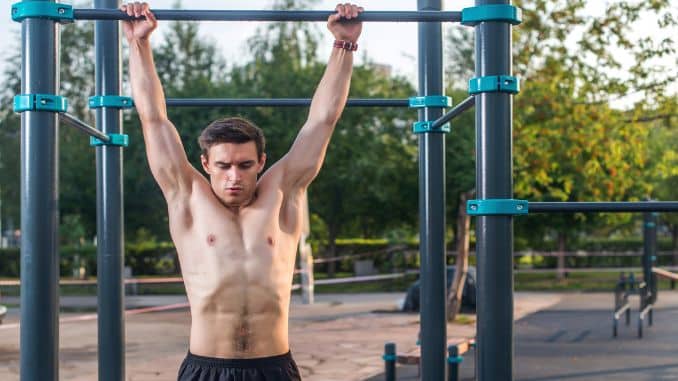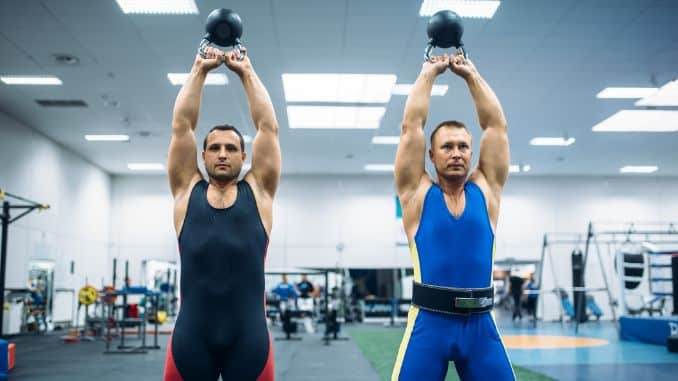Morning! I just wanted to send this out before I head off to the gym to work on my TOP SECRET project.
I am so excited about this. It is going to be AwEsOmE!
Okay, today I have an article from my buddy, Mike Whitfield. Enjoy, and we will talk to you tomorrow.
Rick Kaselj, MS
Muscle “confusion”…
Keeping your body “guessing”…
“Ancient unknown secret” methods…
Random “quotes” on “random” words <== Ha! Hilarious.
You’re probably tired of hearing this type of thing.
The last thing you need is a complicated exercise program; these days, they are getting more difficult to learn… let alone perform.
It’s no wonder you see more injuries.
Besides, I’m guessing you’re busy and don’t have the time to learn 15 exercises.
I wouldn’t be motivated, either! If learning the new workout takes longer than the workout itself…
So, how can you fix it?
It might surprise you.
Not because I’m going to reveal a “secret” combination or anything… but because I’m going to be straight with you
Simply doing MORE of what works is better than a hundred different exercises.
You should hit your pushing muscles, pulling muscles, core, and lower body muscles.

You can EASILY do this with four exercises or LESS…
I call this the “Go BareFit” approach because you’re doing the “bare minimum” to get and stay fit.
That also means FEWER injuries because you’re not doing 100 different exercises in a single workout session.
And because you’re hitting all the major zones of your body, you can get results twice a week.
Ideally, three is better, but if you’re doing it twice a week, be sure to give yourself two days of rest in between so you can focus on doing MORE of what works with the right focus.
Every rep should serve a purpose.
You SHOULD follow a structured program that doesn’t have “fluff” but hits all your major muscles.
Sure, this cranks your metabolism, but your body will “learn” the moves that count.
And when you do them better, you prevent injuries (losing fat is just a plus).
By the way, a Go BareFit workout takes around 30 seconds to memorize.
That means less time learning and more time doing.
Crafting The Perfect Workout Routine
Finding the right number of exercises per workout depends on your experience level, training split, and goals.
Below is a quick breakdown based on different training approaches and objectives.
1. For Beginners: 1-3 Exercises

Best For: New lifters, general fitness, strength building
Beginners should focus on compound movements that target multiple muscle groups in one session.
Full-body workouts require a balance between push, pull, and lower-body exercises to develop strength evenly.
Example breakdown:
- 1 lower-body exercise (e.g., Squat, Romanian Deadlift)
- 1 upper-body exercise (e.g., Bench Press, Row)
- 1-2 core or mobility exercises (e.g., Plank, Hanging Leg Raises)
Keeping the volume moderate ensures proper recovery and prevents being overwhelmed.
2. Intermediate: 2-4 Exercises

Best For: Lifters with 6+ months of experience, muscle building, strength gains
Splitting workouts allows for higher volume per muscle group while maintaining recovery.
Upper/lower and push/pull splits provide more focus on movement patterns (pushing vs. pulling, lower vs. upper).
Example breakdown (Upper Day):
- 2 pressing movements (e.g., Bench Press, Overhead Press)
- 2 pulling movements (e.g., Pull-Ups, Bent-Over Rows)
Example breakdown (Lower Day):
- 1-2 isolation movements (e.g., Bicep Curls, Triceps Extensions)
- 1 core exercise (e.g., Hanging Knee Raises)
A balance of compound and isolation exercises enhances muscle development and strength.
3. Advanced: 3-6 Exercises

Best For: Experienced lifters, bodybuilders, muscle toning
Body part splits allow for maximum volume per muscle group since each session targets only 1-2 muscles.
A higher volume is necessary to induce hypertrophy, but it requires proper recovery.
Example breakdown (Chest & Triceps Day):
- 3-4 compound exercises (e.g., Bench Press, Incline Press, Dips)
- 2-3 isolation exercises (e.g., Chest Flys, Triceps Extensions)
- 1 accessory movement (e.g., Core Work or Shoulder Stability)
Advanced lifters can handle higher volume and intensity while minimizing fatigue.
4. Strength & Power Training: 3-5 Exercises

Best For: Athletes, powerlifters, Olympic lifters
Strength-focused workouts emphasize heavy compund fits with lower reps (1-6 reps per set).
Fewer exercises prevent unnecessary fatigue, allowing for maximum intensity on key movements.
Example breakdown (Lower Body Strength Day):
- 1-2 primary compound lifts (e.g., Squat, Deadlift)
- 1-2 accessory movements (e.g., Bulgarian Split Squats, Hamstring Curls)
- 1-2 mobility or explosive movements (e.g., Box Jumps, Sled Pushes)
Prioritizing quality over quantity ensures strength gains without burnout.
5. Hypertrophy (Muscle Growth): 5-7 Exercises

Best For: Bodybuilders, muscle-focused athletes
Hypertrophy training requires a balance between compound and isolation movements with moderate to high volume.
Higher rep ranges (6-12 reps) and shorter rest periods (30-90 seconds) optimize muscle growth.
Example breakdown (Leg Day):
- 2-3 compound exercises (e.g., Squat, Romanian Deadlifts, Lunges)
- 2-3 isolation exercises (e.g., Leg Curls, Leg Extensions)
- 1-2 core/stability exercises (e.g., Hanging Leg Raises, Cable Side Bends)
Progressive overload is key—gradually increase weight, reps, or intensity to stimulate muscle growth.
6. Fat Loss & Conditioning: 4-6 Exercises

Best For: Weight loss, endurance, athletic conditioning
Workouts focus on a mix of strength, endurance, and cardiovascular components.
More circuit-style training or high-intensity interval training (HIIT) is often included.
Example breakdown (Full-Body Fat Loss Session):
- 2 strength-based movements (e.g., Deadlifts, Push Press)
- 2 cardio-based exercises (e.g., Kettlebell Swings, Battle Ropes)
- 1-2 core or mobility exercises (e.g., Hanging Knee Raises, Russian Twists)
Shorter rest periods (30-60 seconds) keep the heart rate elevated for fat-burning efficiency.
7. Athletic Performance: 4-6 Exercises

Best For: Sports performance, functional fitness, injury prevention
These workouts focus on explosive strength, speed, agility, and mobility.
Power-based exercises help improve performance in sports while preventing injuries.
Example breakdown (Sports Performance Training):
- 2 explosive power movements (e.g., Power Cleans, Box Jumps)
- 2 strength-based exercises (e.g., Front Squats, Pull-Ups)
- 1 mobility/core exercise (e.g., Turkish Get-Ups, Plank Variations)
The focus is on multi-joint movements, balance, and speed, not excessive volume.
Common Mistakes to Avoid

1. Doing Too Many Exercises
One of the biggest mistakes people make is cramming too many exercises into a single session [1].
More exercises don’t always mean better results—if anything, they can slow down progress.
Limit your workouts to 45-60 minutes and focus on how many exercises per workout you include, ideally 3-5 exercises that align with your goals. Track your sessions to ensure you’re not adding unnecessary volume.
When you overload your muscles with excessive volume, your body struggles to recover, leading to fatigue, joint pain, and even muscle loss due to overtraining.
Instead of maximizing the number of exercises, focus on quality over quantity—pick key movements that align with your fitness goals and execute them with proper intensity.
According to Dr. Mark Slabaugh, an orthopedic sports medicine surgeon, experts recommend prioritizing recovery days to allow your muscles time to repair and rebuild, which is crucial for long-term progress.
Additionally, focusing on proper form and technique can help prevent injuries and enhance the effectiveness of your workouts.
2. Not Including Enough Compound Lifts
According to Garett Reid, a strength & conditioning coach and fitness consultant for over 15 years, most lifters—especially beginners—fall into the trap of prioritizing isolation exercises.
Garett adds that while isolation exercises have their place, compound lifts activate multiple muscle groups, build overall strength, and create better hormonal responses for muscle growth.
When planning how many exercises per workout to include, a workout built around 70–80% compound lifts and 20–30% isolation exercises is far more effective than one overloaded with small movements.
3. Ignoring Recovery & Overtraining

Training hard is important, but training smart is even more critical.
Many people underestimate the role of recovery in muscle growth and performance.
If you’re not allowing your muscles enough time to repair [2] and grow, you’re short-circuiting your progress.
Overtraining can lead to chronic fatigue, nagging injuries, loss of strength, and even hormone imbalances.
To avoid this, ensure proper recovery by prioritizing 7-8 hours of sleep per night, staying hydrated, and consuming a protein-rich diet to support muscle repair.
A well-balanced approach will get you far better results than grinding yourself into the ground.
Additionally, be mindful of how many exercises per workout you include to prevent excessive strain and allow for adequate recovery.
4. Randomly Picking Exercises Without a Plan

Walking into the gym without a structured workout plan is like driving without a map—you might end up somewhere, but it won’t be where you need to be.
Many gym-goers waste time randomly picking exercises based on what machines are available or what they “feel like” doing that day.
Without a progressive, goal-oriented plan, it’s hard to track progress, optimize recovery, or ensure balanced muscle development.
Conclusion
When it comes to how many exercises per workout, more isn’t always better—smarter is.
The key is to choose the right number of exercises based on your goals, experience level, and training style.
Whether you’re a beginner sticking to 1-3 key movements or an advanced lifter hitting 5-7 exercises, quality and execution matter more than sheer volume.
Focus on compound lifts, avoid inconsistent and random gym workouts, and ensure proper recovery to maximize gains without burning out.
Train with purpose, stick to a structured plan, and remember—every rep should serve a purpose. Now, go crush your next workout!
Now you know how to structure your exercise routine! For a done-for-you program you can do anywhere, anytime, check out our Bodyweight Blender!
FAQs
Can I train every muscle group in one session, or should I split them up?
Training every muscle group in one session (full-body workouts) can be highly effective, especially for beginners or those training only 3-4 times per week. However, more experienced lifters often benefit from split routines (upper/lower or push/pull) to increase intensity and volume per muscle group. The best approach depends on your schedule, recovery ability, and overall training goals.
How many warm-up sets should I do before starting my main exercises?
Warming up properly is crucial for performance and injury prevention. A good rule of thumb is 1-2 warm-up sets for smaller exercises and 2-4 warm-up sets for heavy compound lifts. These sets should gradually increase in weight but not be so taxing that they fatigue your muscles before the actual workout begins.
Should I change the number of exercises as I get stronger?
Yes, your training should evolve as you progress. As you build strength and endurance, you may need to increase volume (more sets/reps) or intensity (heavier weights), but this doesn’t always mean adding more in your exercise routines. Instead, focus on progressive overload, adjusting variables like reps, weights, and rest times while keeping your workouts structured and effective.
Is there a difference in exercise selection for men and women?
No, the fundamentals of training remain the same for both men and women. However, individual goals may influence exercise selection. For example, women often prioritize glute and leg development, while men may focus more on chest and arm strength. Regardless of gender, compound lifts and proper programming should be the foundation of any routine.
Can I do different exercises every workout, or should I stick to the same ones?
While variety can keep training interesting, consistency is key for progress. Sticking to the same core exercises for 4-8 weeks allows your body to adapt, improve technique, and progressively overload. Too much variation prevents muscle adaptation and makes it difficult to track progress. Instead of constantly switching exercises, try changing rep ranges, tempos, or intensity to keep making gains.


